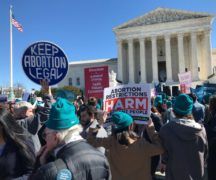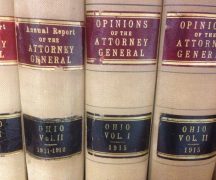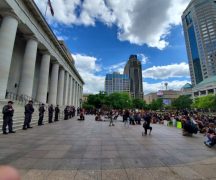By Susan Tebben & Tyler Buchanan
Ohio educators were at home celebrating “Teacher Appreciation Week” in May when they learned cuts would be made at every public school district in the state.
These cuts came just as hundreds of private and charter schools in Ohio were approved to receive millions of dollars from the federal government to keep their workers on payroll. Some of these already receive public school funding as part of the EdChoice private school voucher program.
The federal funding was offered through the Paycheck Protection Program (PPP). It is a program administered by the Small Business Administration which gives low-interest loans to businesses and nonprofits. The loans are forgiven if used primarily to help with payroll costs.
After the federal government released a list of PPP recipients on Monday, the Ohio Capital Journal reviewed data on the nearly 23,000 recipients in this state to track funding that went to schools.
The list does not give an exact dollar figure received by each place, but rather provides a range: $150,000 to $350,000; $350,000 to $1 million; $1-2 million; $2-5 million; and $5-10 million.
In total, the Capital Journal identified 220 schools in Ohio that received PPP funding. The possible range of the combined funding is between $95 million and $232 million.
This money went to a variety of schools. Many are religious institutions, such as Chaminade Julienne Catholic High School in Dayton, which received between $1-2 million. The list includes many charter schools, such as the chain of Horizon Science Academy locations in more than a half-dozen cities which took in millions of dollars.
There are private gifted schools, college preparatory schools and those which operate as nonprofits independent of the traditional public school system. Some are specialized schools for certain areas of study, such as the Global Ambassadors Language Academy in Cleveland, which allows children to learn in language immersion programs for Spanish and Mandarin. The academy took in between $150,000 and $350,000.
Together, the 220 schools were able to retain many thousands of jobs thanks to the PPP funding.
There were additional loans given to Montessori schools, day care centers, pre-schools, after-school programs, summer camps and other entities which serve children. These were not included in the Capital Journal review.
PPP money has been limited to businesses and nonprofit entities, thus making public school districts ineligible for funding.
The Ohio Capital Journal previously reported about a similar disparity within higher education. Dozens of private colleges and universities took in tens of millions of dollars in forgivable PPP loans, while some of Ohio’s public institutions have suffered from severe budget shortfalls in 2020.
Public schools hope for future funding
Public schools are still searching for funding relief after $300 million was cut by Gov. Mike DeWine’s administration in early May as the coronavirus pandemic began to impact state revenues.
Columbus City Schools Superintendent and CEO Talisa L. Dixon told a legislative committeediscussing the future of K-12 education as the cuts took place that uncertainty is the greatest factor facing Ohio schools.
“Uncertainty for the educational programs our families may need and want during this crisis, uncertainty of what our revenues may be as the state discusses further reductions, uncertainty of what our expenses may be in order to bring students back safely,” Dixon said.
The state education system has seen declining growth not just related to coronavirus cuts, but year over year, according to historic data. On top of decreasing budgets, public schools have had to absorb the expenses of sending some students in low-ranked public schools to private schools through the EdChoice program.
The Cleveland Heights-University Heights City School District, for example, saw more than one-third of its state aid deducted for EdChoice scholarships in fiscal year 2019, according to a report done by the district.
According to the PPP awards, a number of Cleveland private schools received funding — examples include the Lutheran High School Association as well as the St. Joseph Academy, each taking in forgivable loans of between $1-2 million.
Hamilton County’s Indian Hill Exempted Village School District had around one-fourth of its state aid diverted to EdChoice private school vouchers, and Sycamore Community City School District lost about one-fifth.
In 2020 PPP awards, nearby schools received loans such as Cincinnati Hills Christian Academy (between $2-$5 million) and St. Ursula Academy (between $1-$2 million).
The leader of a teacher’s union representing 20,000 Ohio educators is taking issue with PPP funding and public school monies going toward private schools. In a recent conference call regarding falling budgets and the need for federal aid, Ohio Federation of Teachers Executive Director Melissa Cropper said the diversion of government funding to private schools has only added to the struggles that impact most students in the state.
“Ninety percent of our students are educated in public schools, so when we have this money diverted to private schools, we’re impacting 90% of the students that the money is being taken away from,” Cropper said. “So this just continues to create disparities within our education system.”
Education advocates see other potential solutions to public schools’ budget woes — namely, funding from the federal CARES Act, a COVID-19 relief bill signed into law back in March. A separate HEROES Act includes more funding for public education, including $3.2 billion earmarked for Ohio schools, but the bill has languished in the U.S. Senate after passing in the U.S. House of Representatives.
***
Also from Ohio Capital Journal:
Ohio’s private colleges received PPP funding as public schools have struggled
A number of private colleges and universities in Ohio benefited from forgivable federal small business loans and retained thousands of local jobs.
Public institutions were not as lucky. Unable to receive the millions of public loan dollars which flowed to private campuses this spring, many have announced deep cuts in recent months. The coronavirus pandemic has added further budgetary strains to public universities already reeling from state funding declines.
More than two-dozen private campuses in Ohio received funding from the Paycheck Protection Program, data released by the federal government on Monday shows.
The program is administered by the Small Business Administration and offers low-interest loans to businesses, nonprofits and other entities to keep workers on their payroll. The loans can be forgiven if the funds are used for payroll costs, mortgage interest, rent or utilities, according to the SBA. READ MORE
Ohio Democratic Party received at least $150,000 through PPP loan
The Ohio Democratic Party received a forgivable loan of between $150,000 and $350,000 from the federal government under a program designed to help small business keep their employees on the payroll.
Paycheck Protection Program data released by the federal government on Monday shows the party was approved for the loan April 30. Unlike with most loan recipients, the data does not state how many jobs were preserved.
ODP spokesperson Kirstin Alvanitakis said Tuesday that 20 jobs were retained at the organization through the use of the program.
“The purpose of the Paycheck Protection Program is to help organizations cover payroll and benefits, and that’s precisely what it has been used for — to ensure our entire team continued to work and earn a paycheck and retain their health coverage during an unprecedented public health crisis,” she said. READ MORE





